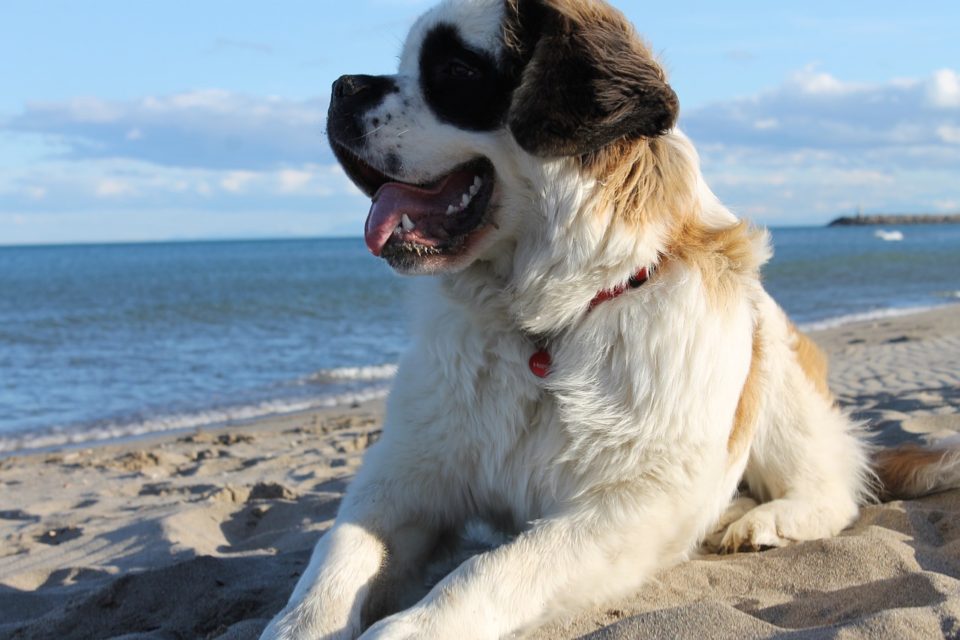If someone were to describe a dog as a gentle giant, you may picture a Saint Bernard or a Newfoundland.
They are both well-known for their sweet disposition and gigantic size–but what sets them apart?
My name is Leah Spaulding and I have two dogs: a rat terrier named Bean and a “wondermutt” named Bandit.
I worked at a holistic pet supply store for three years studying pet care and I’m the vice president of a pet nonprofit organization.
Needless to say, I’ve met many a furry friend–and I’m here to guide you through the similarities and differences of Saint Bernards and Newfoundlands.
If you are considering expanding your family by adding a fur-child, there are a few things to keep in mind.
Ensuring a dog’s activity level, demeanor and needs match your lifestyle is part of responsibly choosing a pet.
In Peter Pan, the dog that looks after the children–Nana–is often portrayed as a Saint Bernard but was originally intended to be modeled after the author’s Newfoundland.
This is a perfect example of how the two dog breeds are thought to possess some of the same fundamental characteristics. Indeed, they are both known for being big dogs that love kids.
However, there are many traits that differentiate the two breeds.
Overview of Saint Bernards
Saint Bernards got their name from the place they originated: The Great Saint Bernard Hospice located on the Italian-Swiss border.
Monks had developed the cold-resistant, powerful dog breed out of necessity.
These dogs located and rescued travelers in need along the pass to Rome. Centuries later, they were popular farming dogs, excellent at herding and guarding farm animals against danger.
From pulling someone out of the snow after an avalanche to herding sheep, Saint Bernards are great working dogs.
The American Kennel Club (AKC) describes Saint Bernards as “playful, charming, [and] inquisitive.” They love playing in the yard and are eager to please their humans.
Overview of Newfoundlands
 Newfoundlands, or Newfies, had their beginning in the North Atlantic as the ultimate fisherman’s companion.
Newfoundlands, or Newfies, had their beginning in the North Atlantic as the ultimate fisherman’s companion.
Their lung capacity, waterproof coat, and webbed feet are perfect for swimming.
Dubbed the “most extreme water-dog on the planet,” they can haul heavy fishing nets to shore, swim long-distances, and even help a drowning person.
A Newfie was even a part of Lewis and Clark’s expedition and is still revered for his heroism for chasing away an angry buffalo among other heroic deeds.
The three words the AKC uses to describe Newfoundlands are “sweet, patient, [and] devoted.” I can attest to those descriptors.
I’ve seen toddlers ride Newfoundland dogs like horses–as the dogs wagged their tails happily.
Saint Bernard vs Newfoundland: Size
Both dogs are extra-large. Saint Bernards weigh in at between 120 to 180 pounds, and Newfoundlands weigh between 100 and 150 pounds.
In terms of height, Saint Bernards and Newfoundlands both average around 27 or 28 inches tall. As a size comparison, their shoulders are at the same height as a nightstand.
Something to note is that both dogs are large enough to unintentionally knock things over -including children.
If your living space is small, you may want to rethink getting a large-breed dog. Similarly, if you drive a small car, you’ll want to consider what travel will be like with your friendly giant.
That being said, Newfoundlands are more suited than Saint Bernards for city living and smaller homes because of their low activity needs.
Saint Bernard vs Newfoundland: Temperament
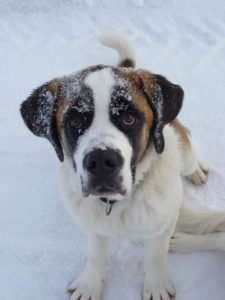 In a scenario where there was a Newfoundland and a Saint Bernard in a room.
In a scenario where there was a Newfoundland and a Saint Bernard in a room.
I would expect the Newfoundland to greet every human in the room one-by-one, and the Saint Bernard to stay next to his humans, inquisitive eyes surveying the scene.
When approached, however, both dogs would welcome the attention with the same gentle sweetness.
The Saint Bernards that I’ve met are sensitive and very tuned-in to their humans–always ensuring they are safe and happy. Newfoundlands like to “work the room” and say hello to everyone.
They both may bark if they perceive imminent danger. Newfoundlands may be slightly more likely to bark than Saint Bernards.
Saint Bernards require an average amount of exercise and activity, and Newfoundlands require low activity.
Newfoundland dogs were bred to swim, and Saint Bernards were bred to be in the snow.
They both, however, have a low tolerance for heat due to their thick undercoats.
Summer weather that we enjoy can be unbearable for them and may lead to heat exhaustion. Special care must be given to ensure they stay cool.
Where you live and the activities you enjoy may be the deciding factor between the two breeds.
Saint Bernard vs Newfoundland: Training
Both dogs are known for being family-friendly working dogs and great with kids, but the Newfoundland is more likely to be better with other dogs and be somewhat easier to train.
Saint Bernards tend to be a little more reserved and stubborn when it comes to training, so it is very important to start their training and socialization early.
Newfoundlands are extremely trainable and respond wonderfully to positive reinforcement training.
They both love people and don’t like being alone. Without proper training and confidence, either can suffer from separation anxiety.
Want to train your Newfoundland or Saint Bernard to do some amazing new tricks, we have created a great article here about brain training!
Saint Bernard vs Newfoundland: Lifespan
Both dogs average lifespan is nearly the same, with Newfoundlands between nine and ten years and Saint Bernards between eight to ten years.
All extra large dogs have a shorter-than-average lifespan, and that is something that you should not consider lightly.
Saint Bernard vs Newfoundland: Health & Diet
 Saint Bernard and Newfoundland dogs are prone to structural problems. The enormous weight on their joints can lead to hip or elbow dysplasia and orthopedic problems.
Saint Bernard and Newfoundland dogs are prone to structural problems. The enormous weight on their joints can lead to hip or elbow dysplasia and orthopedic problems.
It is crucial with both dog breeds to keep them at a lean, healthy weight and to never exercise them strenuously.
In their elderly years, plan on extra care and vet expenses to keep them comfortable.
Newfoundlands and Saint Bernards both do well on high-quality foods, especially ones that are geared toward large-breed dogs.
They can both suffer from bloat, a life-threatening condition, so small meals should be provided throughout the day rather than all at once.
Because they both have floppy ears, they should be checked regularly for any sign of irritation or infection.
Both dogs should have dysplasia and cardiac exams. Saint Bernards specifically should have a DNA test for degenerative myelopathy (a disease that causes loss of coordination) and an ophthalmologist evaluation.
Vets recommend that Newfoundlands get a Cystinuria DNA test (to test for a disease that can cause kidney and bladder stones).
Saint Bernard vs Newfoundland: Appearance
Both of the jumbo dogs have broad heads, bushy tails, medium-sized floppy ears, and drooping jowls.
The coat of a Saint Bernard may have colors ranging from light brown to dark brown or reddish brown–always with patches of white.
There is typically a distinctive strip of white going down the center of their face, parting the dark colors on either side. They can be short-haired or long-haired.
According to the Newfoundland Club of America, “recognized Newfoundland colors are black, brown, gray, and white and black.” Newfoundlands are long-haired.
Both dogs have a thick undercoat that is water-resistant.
Saint Bernard vs Newfoundland: Grooming
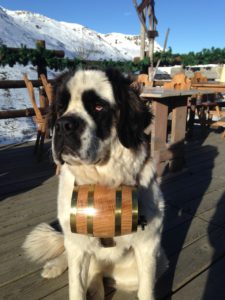 Newfoundlands and Saint Bernards require at least bi-weekly brushing – if not every other day – to keep up with the undercoat.
Newfoundlands and Saint Bernards require at least bi-weekly brushing – if not every other day – to keep up with the undercoat.
If consistent brushing is neglected, matting in the undercoat will form and may cause skin issues.
Brushing your dog is a perfect time to get dog snuggles and kisses, and most pet owners look forward to doing it.
Their nails can be extremely thick and hard to trim manually. Some owners turn to dremels to keep them at a healthy length. Thankfully, both dogs are patient and like attention.
Newfoundlands and Saint Bernards have regular bathing needs. Their oily undercoat protects them from cold and wet, so it is important not to strip their coat of those natural oils.
Because both dogs are shedders, neither is recommended for someone that has pet dander allergies.
Both dogs drool excessively. In my experience, hugging either will result in wet sleeves.
Plan on your house having drool marks on everything below two feet in your house, including your walls. You can also expect a “splash zone” around the dog bowl.
Everyone I know that has a Newfoundland or Saint Bernard keep hand towels everywhere to dab drooly lips and clean up the gifts they leave behind. On the flip side, this quality can be very comedic.
No matter how good you are at grooming your Saint Bernard or Newfoundland regularly, you will still find tufts of fur all over your house, along with the drool.
If you are fond of an immaculately clean house, it will be unachievable with either of these breeds.
Saint Bernard vs Newfoundland: Breed Availability
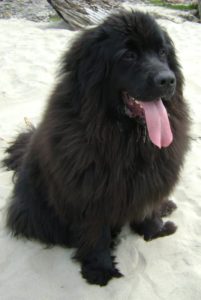 Getting a Newfoundland or a Saint Bernard–depending on where you live–may involve some traveling. They are not as common as other types.
Getting a Newfoundland or a Saint Bernard–depending on where you live–may involve some traveling. They are not as common as other types.
The Newfoundland is the 36th most popular breed, and the Saint Bernard is the 48th, according to the American Kennel Club. Therefore, the Saint Bernard may be slightly harder to find.
Searching local shelters is always my first recommendation when you are looking to add a pet to the family.
Extra-large breeds can end up in shelters because they require more care and are expensive to take care of.
If you are looking for a puppy or cannot find a dog of your preferred breed at a shelter, you may consider buying a dog from a breeder.
Please ensure that your breeder is reputable by asking for references, meeting the breeding pair, and carefully observing the conditions the dog is in.
You should also make sure the parents of the puppy have been tested for genetic diseases.
Buyer beware if anyone selling pets wants to meet you in a parking lot or doesn’t investigate you as a potential pet owner.
If you are worried about the cost of adopting or purchasing a Newfoundland or a Saint Bernard, they are not the dogs for you.
The cost of buying them is nothing compared to the costs of maintaining them.
Saint Bernard vs Newfoundland: Running Costs
Extra-large dogs are some of the most expensive dogs that you can have, comparable to buying a new car!
Costs to consider may include grooming, cleaning products for the home, extra large pet supplies that tend to be more expensive, joint health vitamins, vet bills, surgeries, and extra costs during the elderly years.
Saint Bernard vs Newfoundland: Final Thoughts
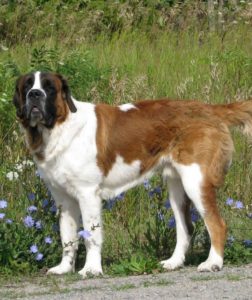 Saint Bernards and Newfoundlands are both big friendly giants.
Saint Bernards and Newfoundlands are both big friendly giants.
If you are looking for a loyal companion that stays by your side and loves the snow, a Saint Bernard may be the dog for you.
If you want a sweet, calm dog that you can take to the lake, the Newfoundland may be the one.
They are both awesome dogs–and I don’t think I’ve ever passed up an opportunity to say hello to either–they both have an enormous presence and enormous hearts.
By doing your research on breeds, you have made a huge step towards making an educated decision for your home!
